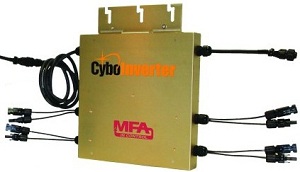New "mini" inverter bridges gap between inverter technology
 Inverters aren’t the flashy part of any photovoltaic array, they’re more like the brains, hidden away on the backside of homes or panels. But they do some pretty heavy lifting by converting the DC (direct current) power produced by photovoltaics and converting it into AC (alternating current) used throughout the world. There have been two types of inverters, centralized and micro-inverters—until now.
Inverters aren’t the flashy part of any photovoltaic array, they’re more like the brains, hidden away on the backside of homes or panels. But they do some pretty heavy lifting by converting the DC (direct current) power produced by photovoltaics and converting it into AC (alternating current) used throughout the world. There have been two types of inverters, centralized and micro-inverters—until now.
CyboEnergy, a subsidiary of CyboSoft, General Cybernation Group Inc. has developed the CyboInverter an intermediary device it’s calling a mini-inverter, which borrows from both inverter and microinverter technology to convert sunlight into usable electricity.
Typical solar installations have traditionally relied on centralized inverters, into which all the panels in an array are connected, and then the power is converted from DC to AC for use in the home. Centralized inverters (albeit larger ones) are also used on solar farms and can handle hundreds of kilowatts of power at the same time.
More recently, companies like Enphase have developed microinverters. These devices convert DC electricity to AC electricity, ready for use in the home, at each individual panel.
In most cases, microinverters cost more for a system than centralized inverters do, but they have some advantages.
In a microinverter system, photovoltaic modules, like in a centralized system, are connected in parallel, meaning that the amount of electricity increases with each successive module. Unlike a centralized system, each microinvertor collects information on the module it’s attached to, including how much power it’s producing or whether or not it needs servicing, and it reports that information back to the system owner and/or the installer. If a panel is impaired in a microinverter system, it doesn’t affect the rest of the modules in the system.
The CyboInverter mini-inverter takes the capabilities of a microinverter and adds in some of the economies of scale gained through a centralized inverter to offer an inverter than can connect to up to four modules at one time. Like a microinverter, it monitors each module individually and sends power production data back to a load center.
“They’re totally scalable. You can add in any combination you want; each port is connected singularly,” said CyboSoft Engineer Manuel Martinez.
The devices, he said can handle a variety of module types at the same time as well.
“It can handle multiple modules up to 1 kilowatt [on each mini-inverter],” he said.
The ideal-size modules, he said, are between 200 watts and 250 watts each, however the mini-inverters can handle modules producing 190 watts.
“We’re still going through our testing phase,” Martinez said. “Costs and whatnot we haven’t determined yet.”
He said those developments and the first solar installation using the devices will all be coming soon.
Image courtesy of CyboSoft.



